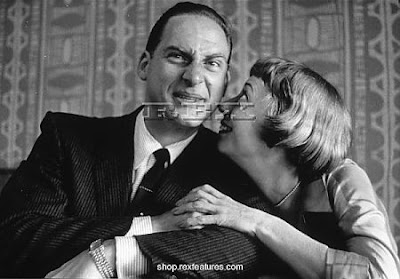
Which do you prefer: the old 1947 version of "Miracle on 34th Street," or the newer 1994 version? It's not a fair comparison because the older version had a bigger budget and some of the best stars and technicians of the day. Good writing, too. Even so, comparison is still possible.
I maintain that the biggest advantage the old version had was a philosophical one. People in those days had a more interesting way of seeing the world. We see things through a depressing Post Modern filter, or at least we did back in 1994 when the remake was made.
Let's take a look at some examples.....
Here's the start of the 1947 version: the titles are superimposed over a traveling backshot of Santa walking along Manhattan streets. Introducing a robust, confident character with a backshot is a great way to create suspense, and the immersion in the life of the city alerts us to the film's subtext, which is that the modern world (and specifically New York) is a wonderful place to live.
Now here's (above) the 1994 version. It starts with a frontal shot of Santa walking down a single street. The shot is made with a long lens, which flattens the background and robs it of its character. No reveal, no subtext, and no color. Why is everything brown? I understand that it's cheaper to shoot this way, but is this really the best the director could do? What went wrong?
What went wrong is that the producer handed off a sentimental 40s story to an unsentimental Post Modern director. Unlike Woody Allen, the director just couldn't bring himself to cast New York in a positive light.
In the newer film Santa's character (above) is established by having him react to an astonished kid who recognizes him. It's not a bad way to go, but the handling was unimaginative. Too many close-ups, too long lenses, too few extras and pedestrian dialogue. And that's not all.
Also at fault is the flat, deliberately deadening Post Modern way of staging. Like atonal music, it's a bleak style that's deliberately meant to be flat and unsettling. Flat anesthetizes the senses. It's a style that fights the sentimental story it's trying to tell. It's a shame because you can tell that Richard Attenburough (Santa) had real enthusiasm for the role.
Here's the old version again. Santa (unseen here) discovers that the parade Santa is drunk , and storms off to report the problem to the coordinator, Maureen O'Hara, pictured above. It's all staged perfectly and there's plenty of extras. Everybody's looking at O'Hara...she's the center of attention, which is a good way to introduce a star.
Here's (above) how the Post Modern version introduces its star. She's in a dark media truck loaded with video monitors. What gives? The parade coordinator is our star, and we can hardly see her.
Okay, it's a cheap way to shoot, but it also fits with the Post Modern, Phillip Glass, trance rhythm of the film. The Post Modern style looks for broad patterns, and resists the notion of making scenes stand out. That's an odd style to choose for a classy story that begs for virtuoso scenes.
I'll add that video monitors are a Post Modern symbol of alienation. How depressing!
Here's (above) the old version showing Natalie Wood and John Payne watching the parade from O'Hara's apartment. Seeing the parade reminds us of the exuberance and grandeur of the city. What the characters say has extra weight because the visuals connect them to the grand adventure below.
Here's (above) a similar shot in the new version. No grand adventure here. Why is everything so dark and flat? And why is the parade reduced to shapes passing by the window? Couldn't the filmmaker afford to rent some stock parade footage?
The bleak graphic treatment makes me feel that the parade is either menacing or uninteresting, and that the foreground figures are hiding out to avoid it. How odd for a film that's supposed to be glorifying Christmas. You get the feeling that the director doesn't really care much about the holiday or about the city. What was the studio thinking?
Do you agree? Rent both versions from Netflix and make the comparison yourself.















































